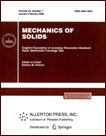 | | Mechanics of Solids
A Journal of Russian Academy of Sciences | | Founded
in January 1966
Issued 6 times a year
Print ISSN 0025-6544
Online ISSN 1934-7936 |
Archive of Issues
| Total articles in the database: | | 13362 |
| In Russian (╚šÔ. đ└═. ╠ĎĎ): | | 8178
|
| In English (Mech. Solids): | | 5184 |
|
| << Previous article | Volume 59, Issue 8 / 2024 | Next article >> |
| Y. Senkoua, F.P. Ewolo Ngak, H.H. Meuyou, and G.E. Ntamack, "Numerical Investigation of the Vibroacoustic Behavior of Carbon Nanotube Reinforced Doubly-Curved Multilayer Composite Shells," Mech. Solids. 59 (8), 4003-4026 (2024) |
| Year |
2024 |
Volume |
59 |
Number |
8 |
Pages |
4003-4026 |
| DOI |
10.1134/S0025654424605093 |
| Title |
Numerical Investigation of the Vibroacoustic Behavior of Carbon Nanotube Reinforced Doubly-Curved Multilayer Composite Shells |
| Author(s) |
Y. Senkoua (Groupe de Mécanique, Matériaux et Acoustique, Département de Physique, Facultés des Sciences, Université de Ngaoundéré, Ngaoundéré, Cameroon, ysenkoua@gmail.com)
F.P. Ewolo Ngak (Groupe de Mécanique, Matériaux et Acoustique, Département de Physique, Facultés des Sciences, Université de Ngaoundéré, Ngaoundéré, Cameroon, ewolongak@gmail.com)
H.H. Meuyou (Groupe de Mécanique, Matériaux et Acoustique, Département de Physique, Facultés des Sciences, Université de Ngaoundéré, Ngaoundéré, Cameroon, meuyouhulk@gmail.com)
G.E. Ntamack (Groupe de Mécanique, Matériaux et Acoustique, Département de Physique, Facultés des Sciences, Université de Ngaoundéré, Ngaoundéré, Cameroon; Department of Fundamental Sciences and Engineering Techniques, School of Chemical Engineering and Mineral Industries, University of Ngaoundéré, Ngaoundéré, Cameroon, guyedgar@yahoo.fr) |
| Abstract |
In this paper, a new approach is suggested to analyze the acoustic transmission of carbon
nanotube (CNT)-reinforced doubly-curved multilayer composite shells by a three-dimensional (3D)
theory, namely the StateľSpace Method coupled with the fourth-order RungeľKutta algorithm
(SSM-RK4). The properties of nanocomposite media are studied using the principle of mixing rules,
which include a number of productivity parameters. Different CNT distributions have been considered, either homogeneous or functionally graded (FG) in the thickness direction. The state equation
is firstly established in the sth layer of the considered structure by coupling the behavior law of structure, the equations of deformation and the movement equations according to the StateľSpace Methodology. The solution of the state equation in the sth layer is taken in the plane wave form, which has
enabled us to transform the latter which a partial derivatives equation into a total derivatives equation.
For the resolution, the fourth-order RungeľKutta algorithm (RK4) is used to obtain the propagation
matrix in the sth layer. The propagation of the solution in the structure yielded the overall transfer
matrix for the structure. Acoustic boundary conditions were applied to obtain the Sound Transmission
Loss (STL). Once the STL has been obtained, various representations are presented to check convergence. Not only the accuracy of this method is confirmed, but its importance is as well demonstrated
by the reliability of the results obtained, particularly in the high-frequency range. Then, using this
method, the effects of different volume fractions, of different CNT distributions, of ratio
(radius/thickness), of incident angle and of geometry on the STL were briefly studied. Our results
showed that these parameters have decisive and predominant effects on the acoustic insulation performance of CNT composite shells. Variations in these parameters shift the positions of the curvature and
coincidence frequencies. |
| Keywords |
CNT doubly-curved multilayer shells, wave propagation, state-space method, RungeľKutta algorithm, 3D theory |
| Received |
21 August 2024 | Revised |
11 December 2024 | Accepted |
11 December 2024 |
| Link to Fulltext |
|
| << Previous article | Volume 59, Issue 8 / 2024 | Next article >> |
|
 If you find a misprint on a webpage, please help us correct it promptly - just highlight and press Ctrl+Enter If you find a misprint on a webpage, please help us correct it promptly - just highlight and press Ctrl+Enter
|
|

 Russian
Russian  English
English